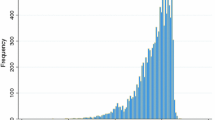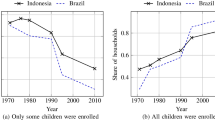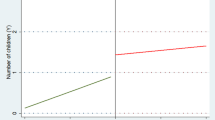Abstract
This paper uses census data to examine the impact of child labor restrictions imposed by compulsory schooling laws and child labor regulation on fertility. By exploiting variation induced by changes in legislation across time and between US states during the early twentieth century, I show that parents chose to have fewer children in response to the constraints imposed on the labor supply of their potential children and the increase in their expected quality. My findings suggest that compulsory schooling laws and child labor regulation contributed to the demographic transition in the US and provide additional empirical support for the notion that financial incentives play a role in determining household fertility decisions.





Similar content being viewed by others
Notes
As pointed out by Clay et al. (2021), 1918 is the traditional date for the passage of the last compulsory attendance law but it was not until 1920 that all the southern states had non-local option laws.
In the analysis, continuation school laws are ignored both for the sake of simplicity and due to the fact that the focus of the research is the impact of child labor restrictions rather than educational attainment.
Milligan (2005) finds that the introduction of a pronatalist tax policy had a substantial impact on the fertility of women in Quebec. Cohen et al. (2013) examine the impact of a sharp reduction in the child allowance in Israel and find that it negatively affects fertility, including that of ultra-Orthodox Jews whose norms generally discourage family planning. Ebenstein et al. (2015) demonstrate how the privatization of Israeli kibbutzim during the mid-1990s, which significantly increased the cost of childbearing for their members, led to a large fertility decline. Consistent with the idea that parents view children as a form of investment, Qian (2008) finds that an increase in the relative income of women in rural China as a result of exogenous shocks to the price of tea (women have a comparative advantage in producing tea relative to other cash crops) had a positive effect on the survival of girls, which had an impact on the country’s gender imbalance.
Notwithstanding, income effects on fertility are hypothesized to be small (Becker1960).
Karen Clay, Jeff Lingwall, and Melvin Stephens Jr were kind to share this data.
Note that using exposure measures based on state-of-birth may attenuate the estimated effects, as a result of measurement error; however, this is preferable to selection induced bias. As a robustness check, I also report estimates based on matching by state-of-residence. The results are qualitatively identical.
In states that had no child labor restrictions in 1900, 18% of all native-born ten-year-olds were employed. Choosing an earlier age such as eight or nine does not meaningfully affect the results.
For a few states that set a literacy requirement instead of a minimum number of years of schooling as a requirement for exemption, the literacy requirement is treated as being as long as the length of a typical primary school course in the state. In cases in which such information is unavailable or less relevant (roughly one percent of all state-year observations), I treat the literacy requirement as a four years of schooling requirement as assumed in previous studies in the literature. The results are not sensitive to whether I assume that the literacy requirement is equivalent to four years of schooling or the length of a typical primary school course. I follow Clay et al. (2021) by using the latter.
Using the number of years a law was in effect during these ten years instead leads to qualitatively identical estimates. Results are therefore not shown.
Exposure in terms of the average school exit age is considered to help determine whether the intensity of restrictions matters. The linear functional form is chosen for simplicity.
In Doepke and Zilibotti’s model, a majority supporting a child labor ban will be formed when the gains of low-skilled workers from eliminating competing child labor exceed the income produced by these workers’ children in the labor force. Accordingly, states with lower fertility rates would adopt laws earlier, since family size ought to be low enough so that the combined income of the children in each household is offset by the increase in parental income when children are banned from the labor force. While incorporating state fixed effects in the model may not completely solve this potential endogeneity problem, it will account for any constant differences in demographic and∖or labor market characteristics across states that may have led to earlier adoption of laws.
Note, however, that here Exposure(20, 30] is no longer indexed by cohort and state like in Eq. (1), but by age, time, and state. The combination of age and time identifies the birth cohort.
Employment is based on being currently employed according to the 1910 and 1930 censuses, or having a gainful occupation in the 1900 and 1920 censuses. School attendance is based on attending school during the previous twelve, seven, five, four, or six months for the 1900, 1910, 1920, and 1930 censuses, respectively. Idleness is defined as not working nor attending school.
In pre-1940 censuses, information on migration is extremely limited. Among those born in the USA, the only indication for migration is current state-of-residence differing from state-of-birth.
In practice, this hardly affects the estimate.
In the absence of information on incomes or wages in pre-1940 censuses, I use the father’s occupational income score as a proxy for income. The IPUMS occupational income score provides a constructed income score based on the relative economic standing of occupations in 1950. For more details, see variable name “OCCSCORE” IPUMS documentation https://usa.ipums.org/usa-action/variables/occscore#description_section. While there has been some debate about the reliability of this variable, especially for imputing income, recent work have shown it is a reasonable proxy for occupational status (Saavedra and Twinam 2020). Importantly, I use it only as a relative ranking of income, and not as an absolute measure of income. I define a low score as a below median occupational income score. Using the father’s occupational standing rather than the mother’s is motivated by the fact that virtually all working-age men were employed in the early twentieth century, while married women had very low labor force participation rates up until WWII.
Infant mortality data were obtained from Mortality Statistics, 1911: General Death Rates, Specific and Standardized Death Rates, Infant and Child Mortality, Causes of Death (Wilbur1913), and Birth, stillbirth, and infant mortality statistics for the birth registration area of the United States: annual reports (of the Census 1925; of the Census 1934). Child mortality data is taken from Mortality Rates 1910–1920 with Population of the Federal Censuses of 1910 and 1920 and Intercensal Estimates of Population (of the Census et al.1923).
References
Aaronson D, Lange F, Mazumder B (2014) Fertility transitions along the extensive and intensive margins. Am Econ Rev 104:3701–3724
Acemoglu D, Angrist J (2000) How large are human-capital externalities? Evidence from compulsory schooling laws. NBER Macroecon Annu 15:9–59
Bailey MJ, Hershbein B (2018) US fertility rates and childbearing, 1800-2010, Oxford Handbook of American Economic History
Bandiera O, Mohnen M, Rasul I, Viarengo M (2018) Nation-building through compulsory schooling during the age of mass migration. Econ J 129:62–109
Becker GS (1960) An economic analysis of fertility, demographic and economic change in developed countries: a conference of the Universities. National Bureau Commitee for Economic Research, 209
Black SE, Devereux PJ, Salvanes KG (2008) Staying in the classroom and out of the maternity ward? The effect of compulsory schooling laws on teenage births. Econ J 118:1025–1054
Bleakley H (2007) Disease and development: evidence from hookworm eradication in the American South. Q J Econ 122:73–117
Bleakley H, Lange F (2009) Chronic disease burden and the interaction of education, fertility, and growth. Rev Econ Stat 91:52–65
Clay K, Lingwall J, Stephens JrM. (2021) Laws, educational outcomes, and returns to schooling evidence from the first wave of US state compulsory attendance laws. Labour Econ 68:101935
Cohen A, Dehejia R, Romanov D (2013) Financial incentives and fertility. Rev Econ Stat 95:1–20
Cook W (1912) A brief survey of the development of compulsory education in the United States. Elem Sch Teach 12:331–335
de Chaisemartin C, D’Haultfœuille X (2020) Two-way fixed effects estimators with heterogeneous treatment effects. Am Econ Rev
de Chaisemartin C, D’Haultfoeuille X, Guyonvarch Y (2019) DID_MULTIPLEGT: Stata module to estimate sharp Difference-in-Difference designs with multiple groups and periods
Deffenbaugh WS et al (1935) Compulsory school attendance laws and their administration
Doepke M (2004) Accounting for fertility decline during the transition to growth. J Econ Growth 9:347–383
Doepke M (2005) Child mortality and fertility decline: Does the Barro-Becker model fit the facts? J Popul Econ 18:337–366
Doepke M, Zilibotti F (2005) The macroeconomics of child labor regulation. Am Econ Rev 95:1492–1524
Ebenstein A, Hazan M, Simhon A (2015) Changing the cost of children and fertility: evidence from the Israeli Kibbutz. Econ J
Eisenberg MJ (1988) Compulsory attendance legislation in America, 1870 to 1915
Galor O (1996) The gender gap, fertility, and growth. Am Econ Rev 3:374–387
Galor O (2012) The demographic transition. Cliometrica 1:1–28
Galor O, Moav O (2002) Natural selection and the origin of economic growth. Q J Econ 4:1133–1191
Galor O, Moav O (2004) From physical to human capital accumulation. Rev Econ Stud 4:1001–1026
Galor O, Weil DN (1999) From Malthusian stagnation to modern growth. Am Econ Rev 2:150–154
Galor O, Weil DN (2000) Population, technology, and growth. Am Econ Rev 4:806–828
Goldin C, Katz LF (2011) Mass secondary schooling and the state, understanding long-run economic growth: geography, institutions, and the knowledge economy, 275
Goldin CD, Katz LF (2009) The race between education and technology. Harvard university press, Harvard
Goodman-Bacon A (2018) Difference-in-differences with variation in treatment timing. Tech. rep., National Bureau of Economic Research
Hazan M, Berdugo B (2002) Child labour, fertility, and economic growth. Econ J 112:810–828
Jensen R (2010) The (perceived) returns to education and the demand for schooling. Q J Econ 125:515–548
Landes WM, Solmon LC (1972) Compulsory schooling legislation: An economic analysis of law and social change in the nineteenth century. J Econ Hist 32:54–91
Laroque G, Salanié B (2008) Does fertility respond to financial incentives?
Lleras-Muney A (2002) Were compulsory attendance and child labor laws effective? An analysis from 1915 to 1939. J Law Econ 45:401–435
Lleras-Muney A (2005) The relationship between education and adult mortality in the United States. Rev Econ Stud 72:189–221
Lochner L, Moretti E (2004) The effect of education on crime: Evidence from prison inmates, arrests, and self-reports. Am Econ Rev 94:155–189
Manacorda M (2006) Child labor and the labor supply of other household members: Evidence from 1920 America. Am Econ Rev 96:1788–1801
Margo RA, Finegan TA (1996) Compulsory schooling legislation and school attendance in turn-of-the century America: A natural experiment approach. Econ Lett 53:103–110
Milligan K (2005) Subsidizing the stork: New evidence on tax incentives and fertility. Rev Econ Stat 87:539–555
Moehling CM (1999) State child labor laws and the decline of child labor. Explor Econ Hist 36:72–106
Nguyen T (2008) Information, role models and perceived returns to education: Experimental evidence from Madagascar. Unpublished manuscript, 6
of the Census USB (1925) Birth, stillbirth, and infant mortality statistics for the birth registration area of the united States: Annual Report, v. 9, U.S. Government Printing Office
of the Census USB (1934) Birth, stillbirth, and infant mortality statistics for the birth registration area of the United States: annual report, v. 17, U.S. Govt. Print. Off
of the Census USB, Davis W, Lappin R (1923) Mortality Rates 1910-1920 with population of the federal censuses of 1910 and 1920 and intercensal estimates of population, U.S. Government Printing Office
Oreopoulos P, Page ME, Stevens AH (2006) The intergenerational effects of compulsory schooling. J Labor Econ 24:729–760
Qian N (2008) Missing women and the price of tea in China: The effect of sex-specific earnings on sex imbalance. Q J Econ 123:1251–1285
Ruggles S, Genadek K, Goeken R, Grover J, Sobek M (2015) Integrated public use microdata series: version 6.0 [dataset]. Minneapolis: University of Minnesota, 2015
Saavedra M, Twinam T (2020) A machine learning approach to improving occupational income scores. Explor Econ Hist 75:101304
Stephens M, Yang D-Y (2014) Compulsory education and the benefits of schooling. Am Econ Rev 104:1777–1792
Wilbur C (1913) Mortality statistics, 1911: general death rates, specific and standardized death rates, infant and child mortality, causes of death, bulletin (United States. Bureau of the Census), Bureau of the Census
Acknowledgements
I thank the editor, Oded Galor, and three anonymous referees for their helpful comments.
Author information
Authors and Affiliations
Corresponding author
Ethics declarations
Conflict of interest
The author declares no competing interests.
Additional information
Responsible editor: Oded Galor
Publisher’s note
Springer Nature remains neutral with regard to jurisdictional claims in published maps and institutional affiliations.
Appendix
Appendix
Rights and permissions
About this article
Cite this article
Shanan, Y. The effect of compulsory schooling laws and child labor restrictions on fertility: evidence from the early twentieth century. J Popul Econ 36, 321–358 (2023). https://doi.org/10.1007/s00148-021-00838-1
Received:
Accepted:
Published:
Issue Date:
DOI: https://doi.org/10.1007/s00148-021-00838-1





